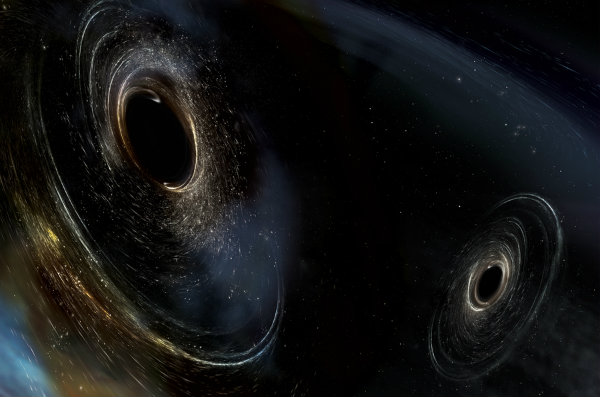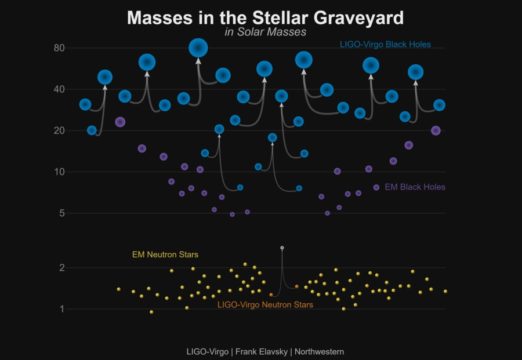A re-analysis of data from LIGO and Virgo brings the number of gravitational-wave detections to 11, including the most distant and most powerful black-hole merger yet discovered.

LIGO / Caltech / MIT / Aurore Simonnet(Sonoma State)
Some 5 billion years ago, in a galaxy far, far away, two huge black holes, weighing in at 34 and 51 solar masses, collapsed and merged into an 80-solar mass monster. The dramatic event unleashed the energy equivalent of 5 solar masses in the form of powerful gravitational waves, propagating through space at the speed of light. On July 29, 2017, these tiny ripples in spacetime — predicted over a century ago by Albert Einstein — reached Earth, where they were detected by the most precise measuring devices ever built by humans.
GW170729, as the gravitational-wave signal is called, is the most distant and most powerful of four new events detected in existing observations of the two U.S. LIGO detectors (Laser Interferometry Gravitational-wave Observatory) and the Virgo detector in Italy. During its first two observing runs, in 2015 and 2017, LIGO spotted seven other events, two of which were also “felt” by Virgo during the 3.5 weeks in August 2017 when the European instrument was operating in parallel with LIGO. A thorough re-analysis of all available data, presented at a gravitational-wave conference in Maryland on December 1st and published online at the astronomy preprint site arXiv.org on November 30th, has now found yet another four events, bringing the total to 11. The other three new ones are designated GW170809, GW170818, and GW170823.
According to Patricia Schmidt (Radboud University, the Netherlands), co-chair of the team that wrote the discovery paper, the new finds help to characterize the population properties of binary black holes and the frequency of their collisions and mergers. In particular, astronomers are eager to learn more about the mass distribution of stellar-mass black holes — the leftovers of supernova explosions. For example, GW170729 poses something of a mystery, since existing stellar evolution models have trouble producing black holes heftier than 50 solar masses.
With the new discoveries, the harvest of the initial observing runs may not yet be complete, says physicist Jo van den Brand (Dutch National Institute for Subatomic Physics, Amsterdam), who is the spokesperson of the European Virgo collaboration. Apart from the four new statistically significant finds, the LIGO/Virgo Collaboration has published a list of 14 “marginal event candidates,” and in February 2019, all data will be publicly released. “External groups may also find something of interest in the data,” says van den Brand.
In a companion paper, the team uses the existing observations to show that the merger rate of binary black holes lies between 10 and 100 mergers per cubic gigaparsec (3.5 x 1028 cubic light-years) per year, and that this number appears to increase with increasing redshift (distance) — exactly what you would expect, given the fact that the cosmic star formation rate was much higher in the past than it is now. However, the results are also consistent with a rate that's uniform over cosmic time.
Right now, all three gravitational-wave detectors are being upgraded for a new simultaneous observing run. “As LIGO and Virgo resume observing in [late March] 2019, we will undoubtedly detect many more binary black hole mergers,” says LIGO executive director David Reitze (Caltech). Given the improved sensitivity of the instruments, scientists expect to find on average at least one event per week. As LIGO spokesperson David Shoemaker (MIT) observes, “it’s an incredibly exciting time.”

LIGO / VIrgo / Northwestern Univ. / Frank Elavsky
References:
The LIGO Scientific Collaboration and the Virgo Collaboration. "GWTC-1: A Gravitational-Wave Transient Catalog of Compact Binary Mergers Observed by LIGO and Virgo during the First and Second Observing Runs." arXiv.org. November 30, 2018.
The LIGO Scientific Collaboration and the Virgo Collaboration. "Binary Black Hole Population Properties Inferred from the First and Second Observing Runs of Advanced LIGO and Advanced Virgo." arXiv.org. November 30, 2018.
Editor's note (January 14, 2019): Edited to add that while the number of binary black hole mergers appears to increase with distance, the results are also consistent with a uniform merger rate over cosmic time.
 0
0









Comments
You must be logged in to post a comment.